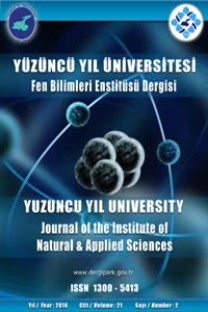Erkek Arı ve Bal Arısı Yetiştiriciliğindeki Önemi
Bal arısı, Yetiştiricilik, Ana arı, Erkek arı
Drones and Their Significance in Beekeeping
Honey bee, beekeeping, queen bee, drone,
___
- Amiri, E., Strand, M.K., Rueppell, O., Trapy, D.R., 2017. Queen Quality and the Impact of Honey Bee Diseases on Queen Health: Potential for Interactions between Two Major Threats to Colony Health. Insects, (8),88: 2-18. Andrew, B. B., Oldryd, B. P., Ratnieks, F. L. W., 2001. Worker reproduction in honey-bees (Apis) and the anarchic syndrome: a review. Behav. Ecol. Sociobol, 50: 199-208. Anonim, 2017. "The Colony and Its Organization." MAAREC - Mid Atlantic Apiculture & Extension Consortium. https://agdev.anr.udel.edu/maarec/honey-bee-biology/the-colony-and-its-organization/ (12.04.2017). Cobey, S., Lawrence, T.,1988. Commercial application and practical use of the Page-Laidlaw closed population breeding program. American Bee Journal, 128, 341–344. Cobey, S.W., 2007. Comparison studies of instrumentally inseminated and naturally mated honey bee queens and factors affecting their performance. Apidologie, 38: 390–410. Crewe, R. M., Velthuis, H. H. W., 1988. False queens: a consequence of mandibular gland signals in worker honeybees. Naturwissenschaften, 67:467-469. Czekonska, K., Chuda-Mickiewicz, B., Chorbinski, P., 2013. The influence of honey bee (Apis mellifera) drone age on volume of semen and viability of spermatozoa. J. Apic. Sci. 57, 61–66. Gempe, T., Hasselmann, M., Schiott, M., Hause, G., Otte ,M. and Beye, M., 2009. Sex determination in honeybees: two separate mechanisms induce and maintain the female pathway. PLoS Biol. 7 (10):e1000222. Genç, F., Dodoloğlu, A., 2002. Arıcılığın temel esasları. Atatürk Üniv. Zir. Fak Yay. No: 166, Atatürk Üniv. Basımevi, Erzurum. Gerula, D., Węgrzynowicz, P., Panasiuk, B., Bieńkowska,M., Skowronek; W., 2016. Productivity and longevity of honey bee queens inseminated with freshly collected and diluted semen. Journal of Apicultural Research 55:2, 130-136. Gupta P, Conrad T, Spötter A, Reinsch N and Bienefeld K., 2012. Simulating a base population in honey bee for molecular genetic studies. Genetics Selection and Evolution, 44(1):14. Güler, A., 2008. Erkek arı yetiştiriciliği ve balarısı (Apis mellifera L.) kolonileri için önemi. Uludağ Arıcılık Dergisi, 8 (3): 106–111. Kaya, F., 2008. Ağrı İlinde arıcılık yapısı ve Değerlendirme raporu. Atatürk Üniversitesi Sosyal bilimler Enstitüsü Dergisi 12 (2): 35-55. Koeniger, G., 2005. The neglected gender - males in bees. Apidologie, 36(2): p. 143-143. Laidlaw, H H, 1979. Contemporary queen rearing. Dadant and Sons Inc., Journal Printing Co., Carthaga, Illinois, USA. Lee, P.C., 1985. Reproduction and growth of temperate-evolved honey bee colonies (Apis mellifera L.). M. Sc. thesis, Simon Fraser University, Burnaby, B.C. Moore, P. A., Wilson, M. E., Skinner, J. A., 2015. Honey bee gueens: Evaluating the most important colony member. eXtension BeeHealth CoP refereed extension review. Moritz, R. F. A., 1984. The effect of different diluents insemination success in the honey bee using mixed semen. Journal of Apicultural Research, 23, 164–167. Rangel, J.; Keller, J.J.; Tarpy, D.R., 2013. The effects of honey bee (Apis mellifera L.) queen reproductive potential on colony growth. Insect Soc., 60: 65–73. Ruttner, F, 1972. Controlled mating and selection of the honey bee. APIMONDIA, 1972, Lunz Am See, Austria. Ruttner, F, 1988. Breeding Techniques and Selection for Breeding of the Honeybee. The British Isles Bee Breeders Association. Verlag, Munich. 152 pp. Schlüns, H., Schlüns, E. A., Van Praagh, J., Moritz, R., 2003. Sperm numbers in drone honeybees (Apis mellifera) depend on body size. Apidologie, 34:577-584. Seeley, T. D., 1978. Life history strategy of the honey bee Apis mellifera. Oecologia, 32, 109–118. Seeley, T.D., Mikheyev, A. S., 2003. Reproductive decisions by honey bee colonies: tuning investment in male production in relation to success in energy acquisition. Insectes Soc 50: 134–138. Suwannapong, G., Benbow, M. E., James C. Nieh, J. C., 2011. Biology of Thai Honeybees: Natural Hsitory and Threats. Biology, Threats and Colonies, 1-98. Winston, M.L., 1987. The Biology of the Honey Bee. Harvard University Press: London, UK. Woyke, J., 1962. Natural and artificial insemination of queen honeybees. Bee World, 43: 21-25. Woyke, J, Skowronek, W., 1974. Spermatogenesis in diploid drones of the honeybee. Journal of Apicultural Research 13:183–190.
- ISSN: 1300-5413
- Yayın Aralığı: 3
- Başlangıç: 1995
- Yayıncı: Van Yüzüncü Yıl Üniversitesi Fen Bilimleri Enstitüsü
Çaldıran/VAN Jeotermal Enerji Kaynakları ve Kullanım Olanaklarının Araştırılması
39K ve 41K İzotoplarının 0-20 MeV Enerji Aralığında Nötron Reaksiyonları Tesir Kesiti Hesaplamaları
Nergiz YILDIZ YORGUN, Ömer Faruk ÖZDEMİR
TARİH BOYUNCA VAN İLİ VE ÇEVRESİNDE BAĞCILIK KÜLTÜRÜ
Ruhan İlknur Gazioglu Şensoy, Ali TUTUŞ
Hoya Formasyonunun (Siirt Batısı) Mikrofasiyes Özellikleri
SES STRESİNİN BAZI İÇ MEKAN SÜS BİTKİLERİNİN POTASYUM, MAGNEZYUM VE KALSİYUM ALIMI ÜZERİNE ETKİLERİ
Doğrudan Metanol Yakıt Pili Anot Katalizörlerinin Sentezi ve Geliştirilmesi
Hilal DEMİR KIVRAK, Berdan ULAŞ
